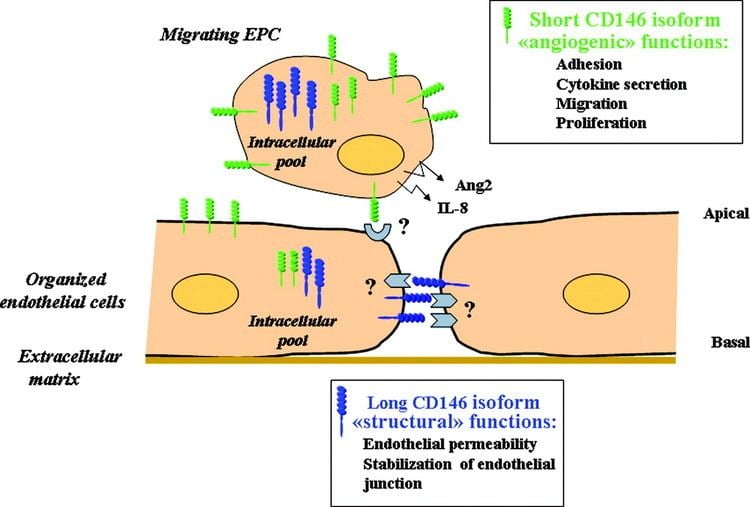Entrez 4162 | Ensembl ENSG00000076706 | |
 | ||
External IDs OMIM: 155735 MGI: 1933966 HomoloGene: 4742 GeneCards: MCAM | ||
Medical vocabulary what does antigens cd146 mean
CD146 (cluster of differentiation 146) also known as the melanoma cell adhesion molecule (MCAM) or cell surface glycoprotein MUC18, is a 113kDa cell adhesion molecule currently used as a marker for endothelial cell lineage. In humans, the CD146 protein is encoded by the MCAM gene.
Contents
- Medical vocabulary what does antigens cd146 mean
- 20161030 cd146 160
- Function
- Clinical significance
- References
20161030 cd146 160
Function
MCAM functions as a receptor for laminin alpha 4, a matrix molecule that is broadly expressed within the vascular wall. Accordingly, MCAM is highly expressed by cells that are components of the blood vessel wall, including vascular endothelial cells, smooth muscle cells and pericytes. Its function is still poorly understood, but evidence points to it being part of the endothelial junction associated with the actin cytoskeleton. A member of the Immunoglobulin superfamily, it consists of five Ig domains, a transmembrane domain, and a cytoplasmic region. It is expressed on chicken embryonic spleen and thymus, activated human T cells, endothelial progenitors such as angioblasts and mesenchymal stem cells, and strongly expressed on blood vessel endothelium and smooth muscle.
Two isoforms exist (MCAM long (MCAM-1), and MCAM short, or MCAM-s) which differ in the length of their cytoplasmic domain. Activation of these isoforms seems to produce functional differences as well. Natural killer cells transfected with MCAM-1 demonstrate decreased rolling velocity and increased cell adhesion to an endothelial cell monolayer and increased microvilli formation while cells transfected with MCAM-s showed no change in adhesion characteristics. Since these characteristics are important in leukocyte extravasation, MCAM-1 may be an important part of the inflammatory response.
CD146 has been demonstrated to appear on a small subset of T and B lymphocytes in the peripheral blood of healthy individuals. The CD146+ T cells display an immunophenotype consistent with effector memory cells and have a distinct gene profile from the CD146- T cells. CD146 T cells have been shown by Dagur and colleagues to produce IL-17.
CD146 has been seen as a marker for mesenchymal stem cells isolated from multiple adult and fetal organs, and its expression may be linked to multipotency; mesenchymal stem cells with greater differentiation potential express higher levels of CD146 on the cell surface.
Clinical significance
MCAM inhibits breast cancer progression.
